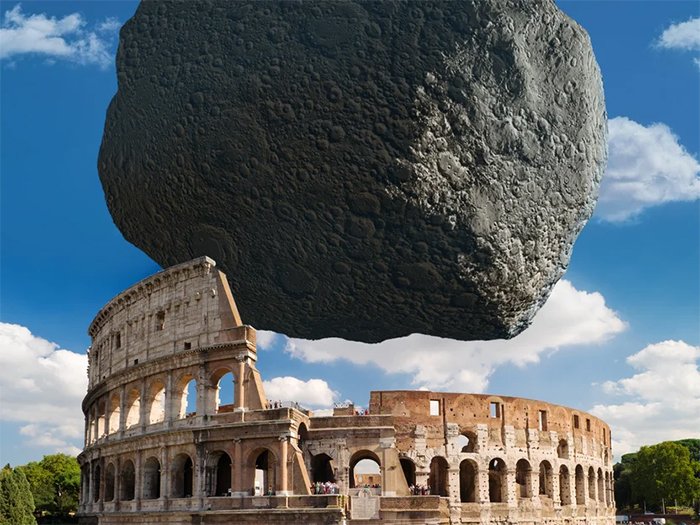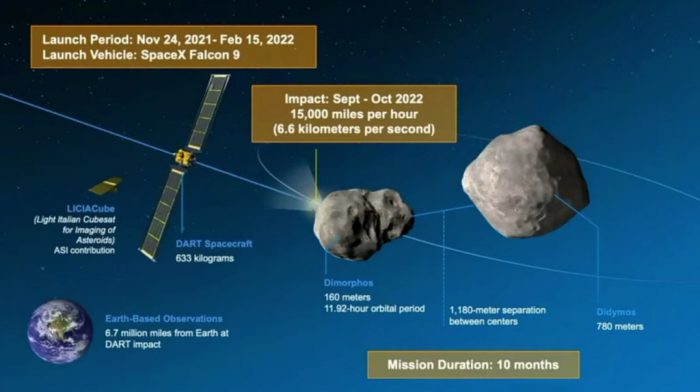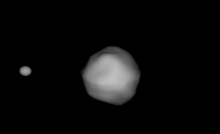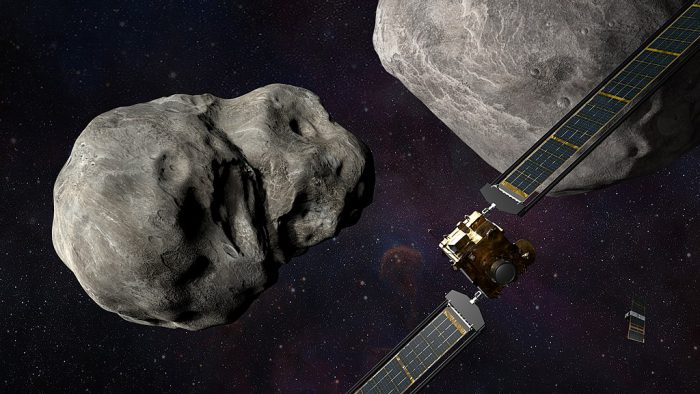So before we get going on this story, let's get this note out of the way: There are no known asteroids on a collision course with Earth!
But that said, there's no denying the history that our planet has with large space rocks. But should an asteroid ever actually be on its way to Earth, we might be able to stop it. Which is why NASA just threw a dart into space.
Hold on, it's actually a mission called DART, or Double Asteroid Redirection Test. Last Wednesday, the golf cart-sized spacecraft was launched on a one-way trip to intercept an asteroid named Dimorphos. What will it do once it gets there?
Buckle up, it's on a crash course!
Nudge, nudge

This art shows the size of Dimorphos compared to the Coliseum in Rome. (ESA)
When you think about a mission to stop an asteroid, it's easy to think of Hollywood-style concepts such as landing a huge bomb on it, or taking aim with a giant laser. But the approach of DART is much more direct and simple. It is going to collide with it at high speed to try and knock it off course.
While Dimorphos isn't coming toward Earth, if it was, it is the kind of asteroid that we might be worried about. It is about the size of a football stadium. And it's the SMALL asteroid. Dimorphos is actually one of a pair of space rocks. It is orbiting the other, the larger asteroid Didymos. Dimorphos orbits Didymos once every 11 hours and 55 minutes.
Smack in the middle

DART's mission should be an impactful one! (NASA)
The idea will be for DART to hit Dimorphos smack in the middle at about 24,140 km (15,000 miles) per hour, which is an unreal 6.6 km per second (the fastest bullet tops out at 1.5 km per second). There are no explosives on board DART—at this speed, even the relatively tiny spacecraft will be an impressive force.
After the impact, scientists estimate that the orbit of Dimorphos around Didymos will be a bit tighter, or about 10 minutes less. What, all that effort for ten minutes less of an orbit?
That may not sound like a lot but it adds up over time. If NASA can intercept an asteroid soon enough, this tiny course correction would be the difference between a collision with Earth and a near—but comfortable—miss.
When it goes down

An imaging of Dimorphos and Didymos based on the data NASA has collected. They have not been able to take an actual photo of the pair. (NASA)
DART is expected to hit Dimorphos in September 2022. Once it is close, it is programmed to take a picture of its target every second and beam it back to Earth. It will also release an even smaller probe—called LICIACube—to record the crash from outside the craft. When all put together, this will give scientists a good record of the encounter (not to mention the first up-close pictures of these two asteroids). And then...
DART will be destroyed, of course. So will we know if it works? In addition to monitoring the asteroid from Earth, the European Space Agency (ESA) is expected to send a follow-up mission—called Hera—to the pair in 2026 to see how everything worked out. How much did Dimorphos' orbit change? How big of a crater did DART leave on its surface? Did it affect Didymos at all? So many questions!
While it's comforting to know that we don't need technology like DART in any real way right now, it's also pretty comforting to know that people are working on it. We're excited to see how this space collision goes!
 An artist's impression of DART, moments before impacting the asteroid Dimorphos. (NASA/JHUAPL/Steve Gribben
An artist's impression of DART, moments before impacting the asteroid Dimorphos. (NASA/JHUAPL/Steve Gribben









